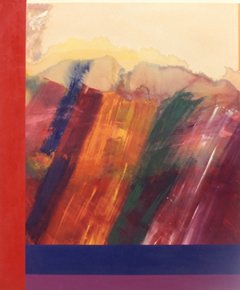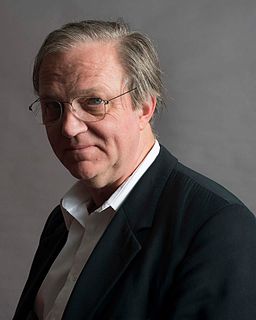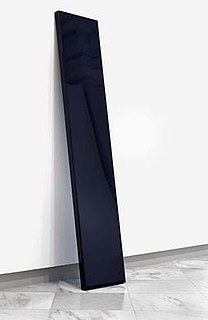Related Research Articles
Raymond Pettibon is an American artist who lives and works in New York City. Pettibon came to prominence in the early 1980s in the southern California punk rock scene, creating posters and album art mainly for groups on SST Records, owned and operated by his older brother, Greg Ginn. He has subsequently become widely recognized in the fine art world for using American iconography variously pulled from literature, art history, philosophy, and religion to politics, sport, and sexuality.
Events from the year 1962 in art.

Ronnie Landfield is an American abstract painter. During his early career from the mid-1960s through the 1970s his paintings were associated with Lyrical Abstraction,, and he was represented by the David Whitney Gallery and the André Emmerich Gallery.
Alison Saar is a Los Angeles, California based sculptor, mixed-media, and installation artist. Her artwork focuses on the African diaspora and black female identity and is influenced by African, Caribbean, and Latin American folk art and spirituality. Saar is well known for "transforming found objects to reflect themes of cultural and social identity, history, and religion."

Robert Storr is an American curator, critic, painter, and writer.

John Harvey McCracken was a minimalist artist. He lived and worked in Los Angeles, Santa Fe, New Mexico, and New York.
Located in Hollywood, Los Angeles Contemporary Exhibitions (LACE) is a nonprofit exhibition space and archive of the visual arts for the city of Los Angeles, California, United States, currently under the leadership of Sarah Russin.

Kenneth Price was an American artist who predominantly created ceramic sculpture. He studied at the Chouinard Art Institute and Otis Art Institute in Los Angeles, before receiving his BFA degree from the University of Southern California in 1956. He continued his studies at Chouinard Art Institute in 1957 and received an MFA degree from New York State College of Ceramics at Alfred University in 1959. Kenneth Price studied ceramics with Peter Voulkos at Otis and was awarded a Tamarind Fellowship.
Ed Moses was an American artist based in Los Angeles and a central figure of postwar West Coast art.

Claes Oldenburg is a Swedish-born American sculptor, best known for his public art installations typically featuring large replicas of everyday objects. Another theme in his work is soft sculpture versions of everyday objects. Many of his works were made in collaboration with his wife, Coosje van Bruggen, who died in 2009; they had been married for 32 years. Oldenburg lives and works in New York.
Peter Sarkisian is an American video and multimedia artist who lives and works in Santa Fe, New Mexico.
Maxwell Hendler is an American painter. In 1975, he became the first contemporary artist to have pictures in the collection of the Metropolitan Museum of Art in New York.
Rachel Lachowicz is an American artist based in Los Angeles, California. She is primarily recognized for appropriating canonical works by modern and contemporary male artists such as Carl Andre and Richard Serra and recreating them using red lipstick.
Carroll Dunham is an American painter. Working since the late 1970s, Dunham's career reached critical renown in the 1980s when he first exhibited with Baskerville + Watson, a decade during which many artists returned to painting. He is known for his conceptual approach to painting and drawing and his interest in exploring the relationship between abstraction and figuration.

Senga Nengudi is an African-American visual artist and curator. She is best known for her abstract sculptures that combine found objects and choreographed performance. She is part of a group of African-American avant-garde artists working in New York City and Los Angeles, from the 1960s and onward.

George Herms is an American artist best known for creating assemblages out of discarded, often rusty, dirty or broken every-day objects, and juxtaposing those objects so as to infuse them with poetry, humor and meaning. He is also known for his works on paper, including works with ink, collage, drawing, paint and poetry. The prolific Herms has also created theater pieces, about which he has said, "I treat it as a Joseph Cornell box big enough that you can walk around in. It's just a continuation of my sculpture, one year at a time." Legendary curator Walter Hopps, who met Herms in 1956, "placed Herms on a dazzling continuum of assemblage artists that includes Pablo Picasso, Kurt Schwitters, Marcel Duchamp, and Joseph Cornell, as well as California luminaries Wallace Berman and Edward Kienholz." Often called a member of the West Coast Beat movement, Herms said that Wallace Berman taught him that "any object, even a mundane cast-off, could be of great interest if contextualized properly." "That’s my whole thing," Herms says. "I turn shit into gold. I just really want to see something I've never seen before." George Herms lives and works in Los Angeles.
Paul Schimmel is an American curator of contemporary art based in Los Angeles. Schimmel served as the chief curator of The Museum of Contemporary Art, Los Angeles (MOCA), from 1990 until 2012, where he organized numerous exhibitions. From 2013 through 2017, he was a vice president and partner with the art gallery Hauser & Wirth and co-founder of Hauser Wirth & Schimmel in Los Angeles. In late February 2017, Schimmel departed from the Hauser & Wirth enterprise, including Hauser Wirth & Schimmel in Los Angeles, with no public comment on his behalf.
Soo Kim is a Korean-American artist. She was born in South Korea in 1969 and moved to Los Angeles in 1980. She earned a B.A. from the University of California, Riverside, and a MFA from California Institute of the Arts. Kim lives in Los Angeles and is on the faculty at Otis College of Art and Design. Kim often employs techniques of cutting and layering in order to introduce areas of absence or disruption in what we tend to take for granted—the interpretation of photographic images."
Nancy Youdelman is a mixed media sculptor who lives and works in Clovis, California. She also taught art at California State University, Fresno from 1999 until her retirement in 2013. "Since the early 1970s Youdelman has been transforming clothing into sculpture, combining women's and girl's dresses, hats, gloves, shoes, and undergarments with a variety of organic materials and common household objects.
Jim Isermann is an American artist. He is based in Palm Springs and Guerneville, California. In 1977 he graduated from University of Wisconsin-Milwaukee and then received an MFA from CalArts in 1980. His artwork has focused on post-war industrial design and architecture. He has participated in numerous exhibitions in art galleries and museum, and has also created large scale commissioned projects utilizing industrial manufacturing processes. His work has been presented in solo exhibitions at Richard Telles, Los Angeles, Praz-Delavallade, Paris (2010), Corvi-Mora, London (2011), Mary Boone Gallery, New York and others. Recent commissioned projects include works for the Hammer Museum in Los Angeles, CA, Yale University Art Museum in New Haven, CT, University of California, Riverside, Los Angeles Metro, and an installation for the Cowboys Stadium in Dallas, TX.
References
- Firmin, Sandra Q.; Julie Joyce, eds. (2007). Mudman: The Odyssey of Kim Jones. The MIT Press. ISBN 978-0-262-56224-9.
- Jones, Kim (ed.) (1990). Rat Piece. Edition of 500 published by the artist.
- Loeffler, Carl E.; Darlene Tong (1989). Performance Anthology: Source Book of California Performance Art. Last Gasp Press and Contemporary Arts Press.
- Murray, Peter (2004). A Cripple in the Right Way May Beat a Racer in the Wrong One: Kim Jones. Exhibition catalogue. Cogh, Ireland: Sirius Art Centre.
- Schimmel, Paul (1998). Out of Actions: Between Performance and the Object 1949–79. Exhibition catalogue. Los Angeles: The Museum of Contemporary Art; and London: Thames and Hudson.
- Storr, Robert (1994). Mapping. Exhibition catalogue. New York: H.N. Abrams.
- Storr, Robert (2003). Disparities & Deformations: Our Grotesque. Santa Fe: SITE Santa Fe; and New York: Distributed Art Publishers.
- Williams, Reese, ed. (1987). Unwinding the Vietnam War: From War into Peace . The Real Comet Press. ISBN 978-0-941104-21-0.